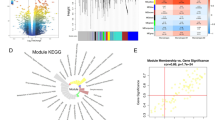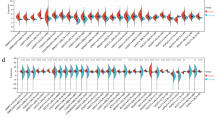Abstract
Background
Sirtuin 5 (SIRT5) is a promising therapeutic target involved in regulating multiple metabolic pathways in cells and organisms. The role of SIRT5 in cancer is currently unclear, and a comprehensive systematic pan-cancer analysis is required to explore its value in diagnosis, prognosis, and immune function.
Methods
We investigated the role of SIRT5 in tumorigenesis, diagnosis, prognosis, metabolic pathways, the immune microenvironment, and pan-cancer therapeutic response. Moreover, we explored chemicals affecting the expression of SIRT5 and computed the relationship between SIRT5 and drug sensitivity. Finally, the role of SIRT5 in melanoma was analyzed using a series of experiments in vitro and in vivo.
Results
We found that SIRT5 is differentially expressed and shows early diagnostic value in various tumors and that somatic cell copy number alterations and DNA methylation contribute to its aberrant expression. SIRT5 expression correlates with clinical features. Besides, it is negatively (positively) correlated with several metabolic pathways and positively (negatively) correlated with several important metastasis-related and immune-related pathways. High SIRT5 expression predicts poor (or good) prognosis in various tumors and can affect drug sensitivity. We also demonstrated that SIRT5 expression significantly correlates with immunomodulator-associated molecules, lymphocyte subpopulation infiltration, and immunotherapeutic response biomarkers. In addition, we showed that SIRT5 is differentially expressed in immunotherapy cohorts. In addition, we explored various chemicals that may affect SIRT5 expression. In conclusion, we demonstrated that SIRT5 is a key pathogenic gene that promotes melanoma progression.
Conclusion
Our study provides a systematic analysis of SIRT5 and its regulatory genes. SIRT5 has excellent diagnostic and prognostic capabilities for many cancers. This may remodel the tumor microenvironment. The potential of SIRT5-based cancer therapies is emphasized and helps predict the response to immunotherapy.





Similar content being viewed by others
Data availability
All data generated or analyzed during this study are included in this published article and its supplementary information files.
References
Anderson NM, Simon MC (2020) The tumor microenvironment. Curr Biol 30(16):R921–R925
Cai S et al (2021) SIRT6 silencing overcomes resistance to sorafenib by promoting ferroptosis in gastric cancer. Biochem Biophys Res Commun 577:158–164
Cerami E et al (2012) The cBio cancer genomics portal: an open platform for exploring multidimensional cancer genomics data. Cancer Discov 2(5):401–404
Chen X et al (2021) Melatonin inhibits lung cancer development by reversing the Warburg effect via stimulating the SIRT3/PDH axis. J Pineal Res 71(2):e12755
Davis AP et al (2021) Comparative toxicogenomics database (CTD): update 2021. Nucleic Acids Res 49(D1):D1138–D1143
Downs-Canner SM et al (2022) B cell function in the Tumor Microenvironment. Annu Rev Immunol 40:169–193
Du L et al (2020) Loss of SIRT4 promotes the self-renewal of breast Cancer stem cells. Theranostics 10(21):9458–9476
Franklin C et al (2017) Immunotherapy in melanoma: recent advances and future directions. Eur J Surg Oncol 43(3):604–611
Gajewski TF, Schreiber H, Fu YX (2013) Innate and adaptive immune cells in the tumor microenvironment. Nat Immunol 14(10):1014–1022
Gao J et al (2013) Integrative analysis of complex cancer genomics and clinical profiles using the cBioPortal. Sci Signal 6(269):pl1
Garcia-Peterson LM et al (2020) The sirtuin 6: an overture in skin cancer. Exp Dermatol 29(2):124–135
Karbasforooshan H et al (2020) The possible role of sirtuins and microRNAs in hepatocellular carcinoma therapy. Cell Cycle 19(23):3209–3221
Lamas NJ et al (2021) Prognostic biomarkers in Uveal Melanoma: the Status Quo, recent advances and future directions. Cancers (Basel), 14(1)
Lamming DW et al (2005) HST2 mediates SIR2-independent life-span extension by calorie restriction. Science 309(5742):1861–1864
Lee E et al (2008) Inferring pathway activity toward precise disease classification. PLoS Comput Biol 4(11):e1000217
Leko V, Rosenberg SA (2020) Identifying and Targeting Human Tumor Antigens for T Cell-Based Immunotherapy of Solid Tumors. Cancer Cell 38(4):454–472
Levavasseur F et al (2023) FOXP1 regulates oxidative stress, SIRT1 expression, and resistance to chemotherapies in acute myeloid leukemia cells. Blood Adv 7(13):3265–3275
Li T et al (2020) TIMER2.0 for analysis of tumor-infiltrating immune cells. Nucleic Acids Res 48(W1):W509–W514
Lin ZF et al (2013) SIRT5 desuccinylates and activates SOD1 to eliminate ROS. Biochem Biophys Res Commun 441(1):191–195
Liu CJ et al (2023) GSCA: an integrated platform for gene set cancer analysis at genomic, pharmacogenomic and immunogenomic levels. Brief Bioinform, 24(1)
Lv XB et al (2015) SUN2 exerts tumor suppressor functions by suppressing the Warburg effect in lung cancer. Sci Rep 5:17940
Mitsogiannis I et al (2022) Prostate cancer immunotherapy. Expert Opin Biol Ther 22(5):577–590
Park J et al (2013) SIRT5-mediated lysine desuccinylation impacts diverse metabolic pathways. Mol Cell 50(6):919–930
Park AK et al (2020) Effective combination immunotherapy using oncolytic viruses to deliver CAR targets to solid tumors. Sci Transl Med, 12(559)
Poniewierska-Baran A, Warias P, Zgutka K (2022) Sirtuins (SIRTs) as a Novel Target in Gastric Cancer. Int J Mol Sci, 23(23)
Ralli M et al (2020) Immunotherapy in the treatment of metastatic melanoma: current knowledge and future directions. J Immunol Res 2020:p9235638
Rardin MJ et al (2013) SIRT5 regulates the mitochondrial lysine succinylome and metabolic networks. Cell Metab 18(6):920–933
Reck M, Remon J, Hellmann MD (2022) First-line immunotherapy for non-small-cell Lung Cancer. J Clin Oncol 40(6):586–597
Singh CK et al (2018) The role of sirtuins in antioxidant and Redox Signaling. Antioxid Redox Signal 28(8):643–661
Thoma C (2018) Kidney cancer: combining targeted and immunotherapy. Nat Rev Urol 15(5):263
Uhlen M et al (2015) Proteomics. Tissue-based map of the human proteome. Science 347(6220):1260419
Vesely MD, Zhang T, Chen L (2022) Resistance mechanisms to Anti-PD Cancer Immunotherapy. Annu Rev Immunol 40:45–74
Wang HL et al (2022) Sirtuin5 protects colorectal cancer from DNA damage by keeping nucleotide availability. Nat Commun 13(1):6121
Wu QJ et al (2022) The sirtuin family in health and disease. Signal Transduct Target Ther 7(1):402
Xu YS et al (2016) STAT3 undergoes Acetylation-dependent mitochondrial translocation to regulate pyruvate metabolism. Sci Rep 6:39517
Yoon KB et al (2016) Induction of Nuclear Enlargement and Senescence by Sirtuin inhibitors in Glioblastoma Cells. Immune Netw 16(3):183–188
Yuan H et al (2019) CancerSEA: a cancer single-cell state atlas. Nucleic Acids Res 47(D1):D900–D908
Zhang Y et al (2021) CSN6 promotes melanoma proliferation and metastasis by controlling the UBR5-mediated ubiquitination and degradation of CDK9. Cell Death Dis 12(1):118
Zhou L et al (2016) SIRT5 promotes IDH2 desuccinylation and G6PD deglutarylation to enhance cellular antioxidant defense. EMBO Rep 17(6):811–822
Funding
This work was supported by funding from the Natural Science Foundation of Hebei Provence (No. H2022206368/No. H2022206446), Natural Science Foundation of China (MianShang project: No. 82372519), Medical Science Research Program of Hebei Provincial Health Commission (No. 20241603).
Author information
Authors and Affiliations
Contributions
Y. J., C. L., Y. L., and S. S. designed and supervised the study. Y. J., C. L., and S. W. performed the experiments. K. Z. and Y. J. analyzed the experimental data. S. S. and Y. J. wrote the manuscript. Y. L. revised the manuscript. All contributing authors read and approved the final manuscript.
Corresponding authors
Ethics declarations
Ethics approval and consent to participate
All animal experiments were supervised and approved by the Committee of Animal Protection and Ethics of Southwest University.
Consent for publication
Not applicable.
Competing interests
The authors declare no competing interests.
Additional information
Publisher’s Note
Springer Nature remains neutral with regard to jurisdictional claims in published maps and institutional affiliations.
Electronic supplementary material
Below is the link to the electronic supplementary material.
Rights and permissions
Springer Nature or its licensor (e.g. a society or other partner) holds exclusive rights to this article under a publishing agreement with the author(s) or other rightsholder(s); author self-archiving of the accepted manuscript version of this article is solely governed by the terms of such publishing agreement and applicable law.
About this article
Cite this article
Ji, Y., Li, C., Wan, S. et al. Comprehensive pan-cancer analysis reveals SIRT5 is a predictive biomarker for prognosis and immunotherapy response. Funct Integr Genomics 24, 60 (2024). https://doi.org/10.1007/s10142-024-01338-7
Received:
Revised:
Accepted:
Published:
DOI: https://doi.org/10.1007/s10142-024-01338-7




